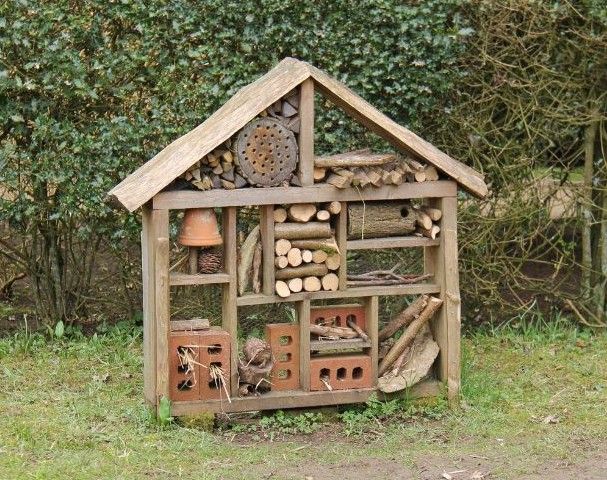Gardening for Pollinators: Habitats that Attract Bees and Wasps
Make A Bug House
An average garden accommodates more than 2,000 different species of insects. Bug hotels are beneficial for gardens as they attract bugs and insects that support biodiversity. They are essential for the ecological balance of the world. The bees and other pollinating species help with pollination. Bees will use this house as a safe place to make their nests and spend the winter months hibernating. Other small insects help attract birds and are essential for soil and other garden benefits. The beneficial bug houses attract these insects that naturally add essential advantages to your garden. To cater for as many of them as possible, site the house where some of it will catch the sun, but the rest will be in the shade under a tree or near a hedge, for example.
Materials you will need:
- Wood
- Dead wood
- Stones and tiles
Filling in the gaps in your bug house, you can use:
- Dead wood
- Hollow stems
- Stones and tiles
- Straw and hay
- Dry Leaves
- Loose bark
- Corrugated cardboard
- Dry sticks
- Milk cartons
- Toilet paper roll
- Bricks
The whole design really depends on your imagination, you can make it really simple or give it more artistic look but what matters the most is creating supportive environment for the important pollinating species.
The bug house should be put out during spring or summer when the wildlife is commonly out and about. An occupied bug hotel should be moved into a cool dry area during winter to protect the wildlife from wind and rain. A garden shed or similar space works great.
Plant some nectar-rich flowers in and around your bug house to provide food for butterflies and bees.
Bug hotels require timely clean-up and maintenance otherwise it may not attract insects and bugs when the next season starts.

Don’t Cleanup Dead Material in Fall or Rush Spring Cleaning
Many insects hibernate for the winter and need a place to bed down. For example, new queen bumblebees are born in the fall. After breeding, they find a place to reside for the cold season, emerging in the spring and starting the next generation. Hole-nesting bees and beetles need things like dead tree trunks or reeds to overwinter in.
So, leave some natural areas of your yard instead of landscaping every inch! Allow material from dead branches and logs to remain as nesting sites, reduce mulch to allow patches of bare ground for ground-nesting bees to utilize, and consider installing wood nesting blocks for wood-nesting natives.
Avoid cutting down everything in the fall, because dead material and hollow stems are lovely homes for pollinators and beneficial insects. Also, do not be in a rush to “spring clean” too early while pollinators like bees and butterflies are still overwintering. A good rule of thumb is to wait until temperatures are consistently about 50°F to ensure a healthy pollinator population all season. When cleaning up in spring, if you notice that some old stems have been used for bee nesting, move them to a corner of your property to give bees a few more weeks to emerge on their own.
Next in our Gardening for Pollinators series, we talk about attracting birds to your garden.
Check out the latest:









